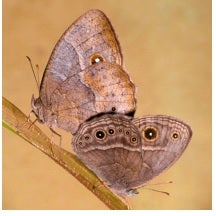How a butterfly changes its spots
Antónia MONTEIRO (Group Leader, Biological Sciences) () November 14, 201514 Nov 2015 NUS-led team is exploring mechanisms that lead to changes in butterfly wing coloration in response to developmental temperature.
A team led by Prof Antónia MONTEIRO from the Department of Biological Sciences in NUS has explored the detailed mechanisms of how temperature interacts with gene regulatory networks to affect the development and the appearance of organisms in adaptive ways. This understanding of mechanism helps them have a better understanding of the consequences that rapid environmental change may bring to organisms.
They found that the brightness of some butterfly eyespots is regulated by temperature, which regulates hormone levels. Higher temperatures lead to higher titers of a steroid hormone, which lead to larger and brighter eyespots. However, not all eyespots respond to temperature in the same way. Invariant eyespots become insensitive to temperature and hormones by down-regulating the steroid hormone receptor during their development.
This is an exquisite organismal adaptation for these butterflies who develop different wing patterns in the dry and wet seasons, in response to temperature. Dry season butterflies, which develop at lower temperatures, reduce the brightness of their hindwing eyespots using the hormone signaling mechanism, but keep their forewing eyespots bright by down-regulating the hormone receptor in those eyespots only. This strategy to reduce brightness of the permanently exposed hindwing eyespots and maintain the brightness of the conditionally displayed forewing eyespots is associated with the need to blend in during the dry season while maintaining some eyespots bright, year round, for use either in mate attraction or predator deflection.
The team is currently exploring additional genetic and physiological mechanisms that lead to adaptive changes in morphology and behavior of butterflies in response to developmental temperature, and how this environmental sensitivity has evolved.

Figure shows the Bicyclus anynana dry season female butterfly (left) mates with a wet season male form. [Image credit: William Piel and Antónia Monteiro]
Reference
Monteiro A, X Tong, A Bear, SF Liew, S Bhardwaj, BR Wasik, A Dinwiddie, C Bastianelli, WF Cheong, MR Wenk, H Cao, KL Prudic. “Differential Expression of Ecdysone Receptor Leads to Variation in Phenotypic Plasticity across Serial Homologs.” PLOS Genetics (2015) 10.1371/journal.pgen.1005529


